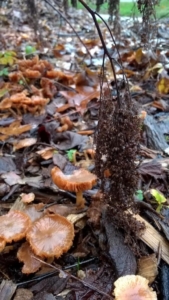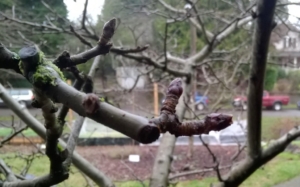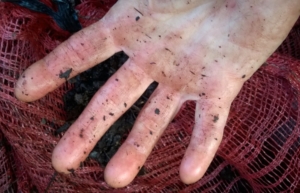January in the Orchard – Is Anything Happening?
Today. Rain. Relative humidity 92%. Many of you would not be thrilled to get out and be active today. However, some of our nature friends are thriving this month. What? Who!
A slow walk at the orchard reveals a lot of activity. Take this camas bulb (Camassia), already popping out of the ground! I put my ear close to the ground and here is what it had to say, “Don’t worry. I know what I am doing. I have been around 1,000  times longer than you guys. I let my foliage pop up to take a peek; my flower buds are still well protected.”
times longer than you guys. I let my foliage pop up to take a peek; my flower buds are still well protected.”
I wandered down to the FECO native plant area. I needed to collect some Ocean Spray (Holodiscus discolor) seeds. The drooping flower clusters were still present and many were holding onto their seeds (actually wooly achenes). I gathered some up and noticed many ‘seeds’ on the ground, along with a lot of leaf litter, plus a good amount of fruiting fungi. This was a spot teaming with activity, more precisely, decomposition. Mostly unseen, the fungi and microfauna, with plenty of water and oxygen, are gobbling down the duff.
Studying the William’s Pride apple buds, it’s clear there are two healthy apples in the making. The tree is ‘dormant’ so we think it’s just resting.
apples in the making. The tree is ‘dormant’ so we think it’s just resting.
“Not so.” blurted out the bud on the right. “We were busy counting chill hours. Now, we are sensing soil temperatures.”
“Ah yes”, I responded. “Well, just chill then.” (No pun intended.) The buds count chill hours, the number of hours when the temperature is between 32 and 45F, beginning November 1. William’s Pride is a low chill apple. After it gets about 500-600 hours logged in, it is ready to respond to warmer temperatures and produce spring growth.
for work parties
Please email to volunteer
freewayestatescommunityorchard@gmail
Then I turned and made a bee-line for the compost pile. I knew it would be active in January. Sure enough, here is a good example of mycelium (the white strands). Pick up some of the organic matter and, if the mycellium strands hold the pieces together, you know you have a mycorrhizal network (versus mold which is wispy and doesn’t completely stick to the substrate).
“Whoa!” the mycelial network complained, “You are not harvesting me to make insulation are you?”
“Oh no”, I replied. “I just wanted to make sure of your identity.”
“Well, just remember, my strong cell walls are made of chitin but still, I can break!”
 After handling the compost, my hands were brown and sticky. The bacterial microbes make glues when they attach to and digest pieces of organic matter. This process starts the formation of micro aggregates in the soil, essential for good soil structure. Fungal mycelia and other microbes also help to stabilize the soil.
After handling the compost, my hands were brown and sticky. The bacterial microbes make glues when they attach to and digest pieces of organic matter. This process starts the formation of micro aggregates in the soil, essential for good soil structure. Fungal mycelia and other microbes also help to stabilize the soil.
Hmm. Which month hosts more metabolic activity: January, when it’s cold and wet or August, when it’s hot and dry? We will answer similarly to the conclusion paragraph of many scientific articles these days, “more detailed investigations are urgently needed in the scenario of global changes”.
Ruth


You’re plants there at FECO sure do a lot of talking! Great article and information. : )
Thanks, Ruth!
Your posts are always interesting and full of good advice and information.